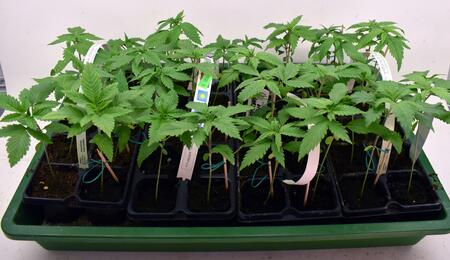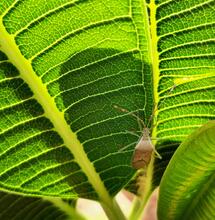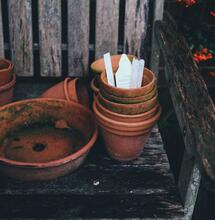Growing Mother plants

Working with quality genetics is an essential factor when producing any type of plants. This is double true when growing cannabis for flower production. Without a high-quality gene pool, the visual and quantitative value of the crop is lower and thus the cultivation is not as effective. One of the proven roads to stable quality and efficiency leads through growing clones cut by growers from mother plants. In this article, we will discuss everything you need to know about growing mother plants. Let’s dive into the subject.
Advantages of mother plants
Mother plants can be a great source of clones. Clones or cuttings are seedlings with a completely identical genetic information. Thanks to this, you can be sure that all plants in your fields, greenhouse or indoor growing room have completely identical predispositions for their height, ripening time, flower and resin production, and, last but not least, terpene and cannabinoid profiles. Different chemotypes and phenotypes never occur when growing clones from one mother plant. This allows you to plan not only the growing process according to your wishes, but also the overall operation of the grow-op, including the prediction of weight and the quality of harvest. When growing from seed, various phenotypes occur relatively often, predominantly in less stabilized strains. And there are many not-so-stable ones on the market due to the massive increase of new varieties in recent years.
First mother plant
The journey to a quality mother plant is long and winding. Basically, there are three starting points. The first is to obtain a clone from some other mother plant that has already been tested and you know that it carries high-quality genes. This road is obviously the simplest and fastest. But you need to know someone who can provide you with such genetics. The second road to take is to grow the mother plant from clones bought in a regular shop. The downside is that you cannot be sure if this mother plant could actually become the ideal foundation stone of your long-term and effective production. Companies that are growing and selling clones try to offer as many strains as possible, but often do not have the capacity to perform reliable and long-term tests on all of them. The third road takes you to your own selection or self-selection – you have to start growing plants from seeds and test their clones gradually in order to be able to choose the most suitable mother for your needs. The disadvantage of this method is that it takes painstakingly long. In case you do not have large growing space and your selections consists of a small number of plants, you may even find yourself in a situation when, even after several months of growing and testing, you still have not found a convenient plant suitable for the production of clones. You cannot compromise here and pick some ordinary mother with average yield and appearance. You want to use the best genetics possible. Nonetheless, self-selection is the most reliable way to eliminate useless individuals and obtain the genetics you have been looking for.
[caption id="attachment_40593" align="alignnone" width="1430"] Proper selection leads to gain perfect genetics[/caption]
Selection
Selection is the process of choosing one mother plant from larger group of plants of a given strain. Make sure to select just one mother plant from each strain you want to start cloning. You can grow as many mother plants from its clones as you need for your production. When all the plants of each strain you grow carry the same genetic information, it is always easier to know what is waiting for you during growing and what results can be expected. The selection can be done with a larger number of clones you obtained from other growers or bought in a store. Seeds can be your starting material, too. When growing from seeds, I recommend using regular (non-feminized) seeds, but it is true nowadays that you can also get quality mothers from feminized seeds. In addition, it is often practically impossible to get hold of regular seeds of many varieties today, so the only way with some strains is to start the selection process with feminised seeds. Throughout the selection, monitor and record all important events. Make sure to properly mark each mother plant involved in the selection process with a unique code and evaluate it regularly. Before you commence, make sure you know exactly what parameters your new mother should have. Sort the parameters by priority. Are you looking for a strain suitable for a multi-floor vertical system? Then the height of your plants will be a top priority for you. Do you contemplate growing plants in the open field and plant them further apart? Then you are looking for plants that grow quickly and have more lateral branches able to fill as much space as possible. When growing outdoors, the plant's suitability for your climatic conditions, resistance to various diseases as well as more tolerance to nutrient deficiencies are the important factors and features, which need to be considered.
I recommend using a simple point system and evaluate your plants accordingly. For example, you can evaluate the monitored parameters on the scale from one to five, where five will be the best mark. The seeds that germinate first will receive five points. On the contrary, the last one to germinate gets only one point. The fastest developing plants will again receive the best rating, and the slower ones will receive the corresponding loss of points. Then you assign the highest mark to plants growing in a way that best suits your growing system. A particularly important part of keeping the score comes once you start cutting test clones from a group of mother plants competing for the win – give five points to the individuals whose clones rooted first. When you make the first (test) clones, there are two selection options. You can either let the plants you made clones from flower, or you can try to grow and harvest the clones. I recommend the second method. Ideally, you end up with five to ten quality clones from each potential mother plant, then divide them into groups, and grow them all under the same conditions until they are fully mature. All you have to do is observe each group as a whole, but if you want to obtain more detailed information, you can observe each plant in each group individually. Again – evaluate the monitored parameters until the harvest. It goes without question that yield, appearance, and chemical structure play an important role in every single selection process – so, if you feel like it, you can assign double points to some or all of the above mentioned parameters.
[caption id="attachment_40594" align="alignnone" width="1920"] Test clones will show how good is their mother plant[/caption]
The results of growing a group of plants of five to ten would provide you way more accurate information about the overall quality of potential mother plant from which the clones of the given group come from. When growing regular seeds, make sure to choose a smaller number of plants in each group, i.e. five. Once you have identified groups that come from male plants, you will still be able to use the growing area efficiently, as you will not have to get rid of such a large number of plants. You can also throw away mother plants whose clones grew into male plants. However, if you want to produce your own seeds or breed your own varieties, choose the best ones from the male groups as well. I do not need to remind you that avoiding pollination during selection is a must. Pollinated female plants create seeds in flowers and the yield of quality dry material is lower and the same counts for the absolute production of cannabinoids and terpenes.
What can be also done is to leave the first test clones in the growing stage and initiate flowering in the mother plants. This way, you will soon find out necessary information about the yield, appearance or possible occurrence of males. However, information obtained from only one plant is not sufficient enough. Any fluctuation in fertilization, watering or even the light cycle can negatively affect one plant. But if you test a whole group, you actually obtain real and useful data. Evaluate the data carefully after the harvest as well. Select one plant of the strain whose clones received the most points during selection. If some plants received the same number of points, simply choose the one you like best. Make clones from it and let them become you mother plants for clone production. It is advisable to grow more mother plants just to be covered in case one mother dies for some reason. Keeping just one mother plant is quite risky, especially if you put so much effort into the selection.
Growing and lifespan
Always keep your mother plants in the vegetative stage. When growing hydroponically, provide them a nutrient solution with EC around 1.7 and a pH between 6.2 and 6.5. The difference between day and night temperature should be kept at 2–4 °C, while the daytime temperature should not exceed 28 °C (at least not much). Keep the relative humidity at 60–70%. When growing in soil or substrate, provide nutrients the same way you do in the growing stage. Do not forget that larger plants need to be fertilized more often. In the case of mother plants, nutrient deficiencies usually begin to manifest in the lightening of the leaves, which eventually begin to turn yellow. If this issue occurs after longer period of growth and production of clones, these mother plants need to be revitalized. You can either move them into larger containers, or select the most visually perfect and strongest of their clones and replace old mothers with them. Although the mother plant can live for several years, I recommend renewing them every six to twelve months, depending on how often you cut clones from them. The optimal frequency for cutting clones from mother plant is, at least in my opinion, two to four weeks. In two weeks, enough suitable shoots will be formed ready for another collection. If you are not cutting clones, you should at least trim it and adjust its shape every four weeks. When you maintain the proper shape, the cutting of clones is easier and it also contributes to their uniform size.
Mr. José info@mrjose.eu



.png)